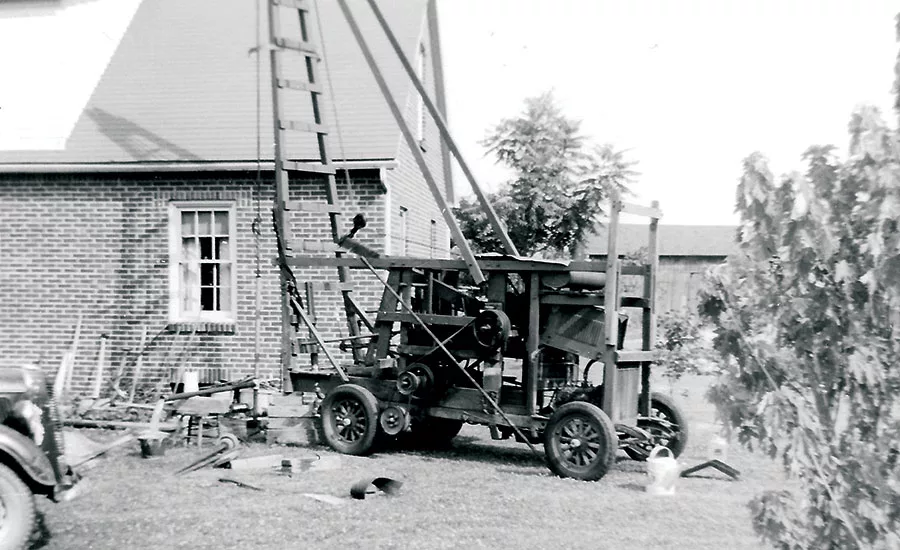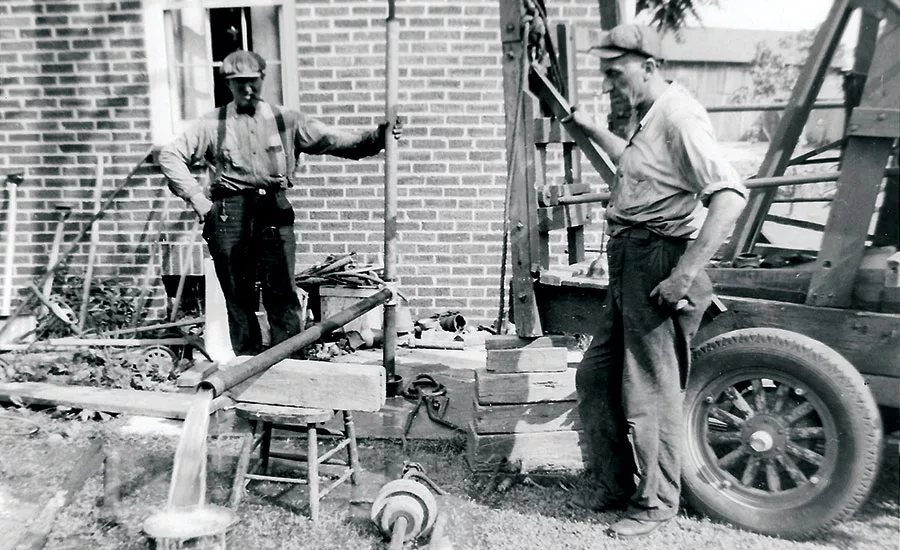A Look at Early Water Well Drilling Rigs

Columnist John Schmitt’s father and uncle install a well using the rig the veteran driller cut his teeth on.
Source: John Schmitt photos

As I wrote last month, this will be the first of a few columns on the first well rig I ever had experience with. My dad, as I have written, worked for a farm implement dealer from about 1921 until the dealership sold in April 1945. At that time, he formed his own business, J.P. Schmitt & Co., which I own and operate today. We never did sell farm equipment. We drilled wells, and sold and serviced water pumps.
The firm that Dad worked for had a franchise for Allis Chalmers farm equipment, and later also sold the Oliver brand. In addition, they sold milking machines, electrical generators (which were quite popular, since many rural areas had no power lines) and water pumps. In those days in this region, a well driller drilled a well, laid down the mast and was gone. Pumps were installed by plumbers, farm equipment dealers, and handymen — whomever, really. Today in Michigan, most all well drillers install and service pumps — a big change from the 1920s, ’30s and the ’40s up through the end of World Word II.
I’m writing about this old well rig to give younger readers an idea of the equipment our industry used in days long gone by. I think many readers will scratch their heads and wonder how we ever got anything accomplished in those days. The difference between 2019 and those old rigs is about the difference between the space shuttle and the Wright brothers’ first airplane. As an older man and longtime member of the industry, when I’m gone — and my colleagues are too — there won’t be any first-hand recollections of using these crude, old well rigs. Believe me, readers, many people drilled wells with rigs like this, although some were fortunate enough to have a factory rig made by Armstrong (later Bucyrus-Erie), Speedstar, Loomis, Ideco or other brands too numerous to mention. Anyway, here goes a description of the first rig I ever had experience with.
Sometime in the late 1920s or the early ’30s, my dad installed a pump or two on wells with a plugged well screen. These plugged screens were quite common in that era. In past articles, I have described different types of well screens and I will not rewrite that information here. I will just say that plugged screens were not unusual and that the remedy was to pull out the old one and install a new one. We are talking mostly about 2-, 3- and 4-inch wells, which were common on rural homes and farms in this area.
Most of the farmers milked cows and I understand a good milk cow will drink about 35 gallons of water a day, so a good supply was really a necessity if the farmer had any kind of a herd. So my father informed his boss that they needed a well rig. They found one about 50 miles away and bought it.
Whoever built this rig started with the chassis of a Star brand car, a product of the Durant Motors Company. I have never seen a Star car, but this well rig/car somewhat resembled a Ford Model A. It had a 4-cylindar flat head engine (perhaps a Continental), a 3-speed transmission with a gear shift coming vertically out of the transmission case and wooden spoke wheels. The original builder tore off most of the cab or body, but left the steering wheel and the operating pedals: the clutch, brakes and accelerator. He added a sort of a wooden box for the driver to sit on. I don’t remember there being any lights, front or rear, or even a windshield. Yes, they drove this thing down the road. Originally, this rig was what we might call a drum or cathead machine. It had a rotating drum about 2½-feet-long that was used like a cathead with the drilling rope wrapped around it one or two times.
A second rear axle drove the drum. This second axle added near the regular rear axle had a couple V-belt sheaves instead of wheels. The driller or his helper drove this thing to the jobsite, and then got out and got under it to change the drive shaft. There were two drive shafts: one connected to the axle powered the machine down the road and another shorter one powered the axle that ran the mechanism. In one of the two photos with this column, you can see the axle that powered the drilling machinery just ahead of the rear wheels. This, of course, was a 1920s version of today’s power divider.
In the same photo, readers can see the machine is equipped with a tongue on the front. It rests on the ground partially hidden by a sprinkling can. The sprinkling can was to refill the radiator, as the old flat head engine frequently overheated. By the time of this picture, my dad had gotten sick of changing drive shafts and towed the rig around as a 4-wheel trailer. It trailed poorly, wandering all over the road. At times, my dad had to stop and start up again for fear the rig would tip over or throw the towing pickup into the ditch. Yes, readers, this really did happen.
If you haven’t busted a stomach muscle laughing at this machine by now, stay tuned for the next chapters. I will have other pictures, including one of me up on the mast at the age of about 12 or 13 attaching the 2-by-6 wooden braces used to raise the mast and support it in the working position.
As I write this just before Thanksgiving, winter has come to Michigan in late fall. A week ago, we got about 5 or 6 inches of wet, nasty snow and a couple nights of temperatures below 0 degrees Fahrenheit. Now the weather has turned warmer and everything is mud. My trusty lawn-mowing tractor is now my trusty snowplow and, believe me, the conversion is not easy. I got valuable help for that chore from a strong and beloved son-in-law.
You will be reading this in 2020 and it seems to my wife and I that everyone was all worried when the century ended and the year 2000 began. A lot of folks thought the world was coming to an end. Obviously, it did not. That seems like that was yesterday but, gosh, it was 20 years ago. Happy New Year to one and all and I hope you had a wonderful holiday season. Stay tuned for my next article on this really, really old well drilling rig.
For more John Schmitt columns, visit www.thedriller.com/schmitt.
Looking for a reprint of this article?
From high-res PDFs to custom plaques, order your copy today!




